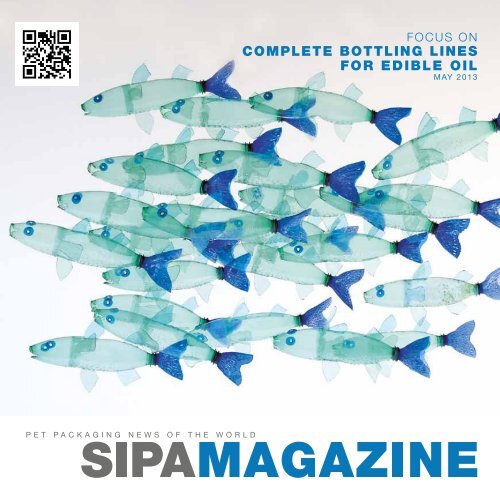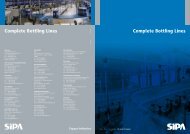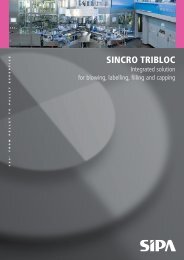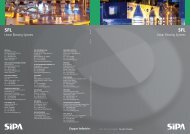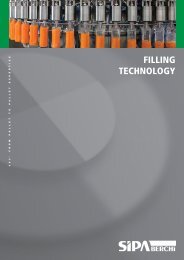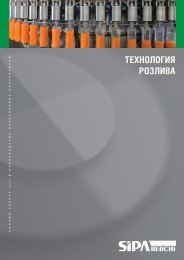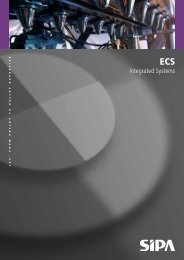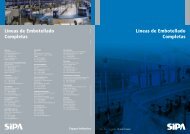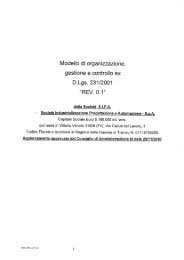C14_SIPA Magazine_issue4_2013_uk.pdf
C14_SIPA Magazine_issue4_2013_uk.pdf
C14_SIPA Magazine_issue4_2013_uk.pdf
You also want an ePaper? Increase the reach of your titles
YUMPU automatically turns print PDFs into web optimized ePapers that Google loves.
Focus on<br />
complete bottling lines<br />
for edible oil<br />
MAY <strong>2013</strong>
_2<br />
Published by:<br />
<strong>SIPA</strong> S.p.A.<br />
via Caduti del lavoro, 3<br />
31029 Vittorio Veneto - italy<br />
+39 0438 911511<br />
www.sipa.it<br />
Thanks for ConTribuTions To:<br />
logoplaste<br />
CbC<br />
lightweight Containers<br />
little Green beverages<br />
danone<br />
Zhongfu Group<br />
Published on:<br />
May <strong>2013</strong><br />
CrediTs:<br />
istockfoto, shutterstock, 123rf<br />
Concept, design, layout:<br />
sts italiana<br />
CoVer:<br />
www.veronikarichterova.com<br />
SUMMARY<br />
5<br />
7<br />
9<br />
13<br />
17<br />
20<br />
25<br />
28<br />
33<br />
34<br />
editorial<br />
innoVaTe To CoMPeTe: see you<br />
aT drinkTeC<br />
AROUND THE GLOBE<br />
neWs froM The<br />
differenT ConTinenTs<br />
loGoPlaste - usa<br />
loGoPlasTe fills holes<br />
in The Walls WiTh siPa MaChines<br />
cBc - central aMerica<br />
CbC: a CenTral aMeriCan ChaMPion<br />
Chooses siPa<br />
KeY KeG - tHe netHerlands<br />
siPa deVeloPs The ConTainer-in-<br />
ConTainer keykeG<br />
little Green BeVeraGes -<br />
soutH aFrica<br />
siPa helPs liTTle Green beVeraGes<br />
refreshhh souTh afriCa<br />
danone - uKraine<br />
siPa saTisfies danone in <strong>uk</strong>raine<br />
ZHonGFu GrouP - cHina<br />
siPa ProVide a besT MaChine soluTion<br />
for Zhuhai ZhonGfu<br />
FOCUS ON<br />
CoMPleTe boTTlinG lines<br />
for edible oil<br />
coMPlete BottlinG<br />
lines For ediBle oil<br />
siPa has desiGns on edible<br />
oil boTTlinG lines<br />
41<br />
43<br />
46<br />
51<br />
52<br />
54<br />
56<br />
58<br />
62<br />
66<br />
TECHNICAL WINDOW<br />
on siPa ProduCT PorTfolio:<br />
laTesT deVeloPMen<br />
atHena & siPa<br />
siPa ParTners WiTh aThena auToMaTion<br />
To launCh a neW PeT PreforM sisTeM<br />
sFr eVo 3<br />
sfr eVo 3 Takes siPa’s roTary bloW MoldinG<br />
equiPMenT To The nexT leVel<br />
PETWORK<br />
ConCePT, desiGn, enGineerinG. WhaT’s neW<br />
in PaCkaGinG World<br />
siPa concePt<br />
PuTTinG PasTa in PeT<br />
144 caVities<br />
niaGara falls for siPa in dallas<br />
HotliGHt 28<br />
hoTliGhT 28 sParkinG a reVoluTion<br />
SQUEEZABLE HOT FILL<br />
forM and funCTion CoMe ToGeTher<br />
in neW keTChuP boTTle desiGn<br />
JUST AROUND <strong>SIPA</strong><br />
The arT of Glass<br />
neXt eVents <strong>2013</strong>/2014<br />
_3
_4<br />
Athena and <strong>SIPA</strong> team.<br />
EDITORIAL<br />
We live in interesting times, we all face numerous challenges. Many traditional markets are<br />
weak, forecasting market developments seems to have more to do with necromancy than<br />
economics. uncertainty prevails. and even if, as the cliché goes, packaging is recessionproof<br />
- we always need to eat and drink – our industry still needs to innovate to compete.<br />
That is what siPa does best. as articles in this magazine testify, siPa continues to come up<br />
with new packaging solutions to make our customers’ business better: lightweight bottle<br />
necks and bases; striking designs that stand out on supermarket shelves; equipment that<br />
is more energy-efficient and easier to operate. equipment too that is easy to adapt to new production requirements and market trends:<br />
a beverage player can for example quickly and easily produce and fill bottles for hot fill applications and bottles for Csd on the same<br />
bottling line thanks to adaptable blowing parts and filling valves, capable of handling both products. siPa’s new partnership with athena<br />
automation in the development of high-efficiency PeT preform injection molding machines is another prime example of our innovative<br />
spirit. athena automation is headed by robert schad, one of the pioneers of PeT preform production technologies. The new small and<br />
medium-sized machines, which perfectly complement our recently introduced large xforM 500, will further increase sustainability at<br />
preform makers. We must also mention the latest manifestation of our sfr rotary stretch-blow molding machines, the eVo 3 , the fastest,<br />
most versatile, and most cost-effective generation yet. Consider also siPa’s offering for companies bottling edible oils: working with topranking<br />
partners in weight filling technology, we have put ourselves at the leading edge in developments that reduce losses to a minimum<br />
and maximize the value of these important products. siPa is also extending its life Cycle services, lCs. This very important part of our<br />
total customer support package can increase the overall effectiveness of our customers’ operations, through such activities as improving the<br />
reliability and availability of equipment, analyzing productivity and part quality, improving performance, turning extraordinary maintenance<br />
into ordinary maintenance, and collaborating on future planning. The key factor in lCs is for us to understand and provide what<br />
the customer really wants. lCs is all - encompassing: lightweighting, format changing, packaging developments, auditing and training,<br />
revamping of existing assets, repairing, conversions, development of new products, remote service & technical support, data acquisition,<br />
maintenance management, line analysis, relocation and service contracts in general - all of these things should be a natural choice and not<br />
just an option for the customer. With lCs, we will strengthen our bond with our customers, increase our interactivity, and become true<br />
partners with them. What else can our customers, our partners, expect from siPa in the near future? as i said at the beginning, you need<br />
to innovate to compete. drinktec in Munich is just around the corner - september 16 to 20 - and siPa is ready to unveil a revolutionary<br />
packaging production systems. revolutions in technology - think tablets, car park assist, internet-connected homes - often appear to fulfil<br />
a need you never knew you had; but when you have them, you wonder how you ever managed without them.<br />
This is what we want to show you. We are sure your time with us will be most interesting.<br />
Enrico Gribaudo<br />
General Manager<br />
_5
_6<br />
AROUND THE GLOBE:<br />
NEWS FROM THE<br />
DIFFERENT CONTINENTS<br />
_7
if you are a bottling company<br />
and you see a hole in your wall,<br />
there is a very good chance that<br />
logoplaste is on the other side of<br />
it. The Portuguese company has<br />
been pioneering the practice of<br />
locating dedicated rigid plastics<br />
package molding operations right<br />
next to the packaging customer<br />
for over 35 years.<br />
The packages may not always pass<br />
literally through a hole in the wall,<br />
but the speed of delivery makes it<br />
feel as if they did. The logoplaste<br />
operation is integrated not only<br />
with the customer’s building but<br />
also with its infrastructure. it has<br />
numerous partners, especially in<br />
europe and brazil.<br />
now it is building up its presence<br />
in north america. one of the<br />
world’s largest producers of spirits,<br />
wines and beer is among the<br />
around tHe GloBe - usa<br />
LOGOpLASTE FILLS<br />
HOLES IN THE WALLS<br />
WITH SIpA MACHINES<br />
_8 _9
_10<br />
latest major companies to benefit<br />
from the symbiotic system.<br />
since 2007, this drinks company<br />
has invested heavily at a plant<br />
near Chicago where it makes<br />
various vodka and gin brands,<br />
as well as flavoured beers. This is<br />
one of the largest combined spirit<br />
and malt beverage facilities in the<br />
around tHe GloBe - usa<br />
world. it produces more than 12<br />
million cases of spirits a year.<br />
the versAtilitY of sipA<br />
sfl in plAinfielD, illinois<br />
Complementing that investment<br />
was one by logoplaste.<br />
Together with its drinks company<br />
partner, it has established<br />
logoplaste Plainfield llC, a<br />
PeT bottle production unit built<br />
within the bottling plant.<br />
between 2010 and 2011, siPa<br />
installed six sfl 6/6 linear blow<br />
molding units there. all are connected<br />
to a sophisticated palletising<br />
unit.<br />
full pallets are then transferred<br />
from the blowing operation to<br />
the filling lines.<br />
The sfl 6/6 machines produce<br />
bottles in a wide range of sizes,<br />
from 0.2 to 1.75 liters in volume,<br />
in oval and round shapes<br />
and with various neck heights. in<br />
total, there are more than 20 different<br />
formats, based on several<br />
different preform designs.<br />
according to logoplaste, the onsite<br />
PeT production facility is<br />
the first of its kind for the spirits<br />
industry. it produces enough<br />
PeT bottles to meet the vast<br />
majority of bottling needs at the<br />
partner’s site.<br />
Different shApes AnD<br />
sizes, one MAchine<br />
“logoplaste likes our machines<br />
particularly for their versatility”,<br />
says denis Marcon siPa north<br />
america director.<br />
“They can make lots of different<br />
shapes and sizes, and changeover<br />
from one to another is simple and<br />
fast.” he also highlights the ease<br />
of process setting through modular<br />
ovens, electrical brushless preform<br />
stretching, monobloc blowing<br />
valves with independent seals<br />
and fast response times.<br />
such was the success of the new<br />
installation that logoplaste took<br />
another three siPa sfl 6/6 units<br />
when it opened a second client<br />
dedicated facility in the Midwest,<br />
earlier this year, intended to supply<br />
other customers.<br />
The drinks company for its part<br />
says the on-site resource is helping<br />
it reduce its carbon footprint,<br />
since no longer has to truck bottles<br />
into the facility.<br />
and it says it can react much<br />
more quickly to fluctuations in<br />
production forecasts.<br />
around tHe GloBe - usa<br />
_11
_12<br />
around tHe GloBe - central aMerica<br />
CBC: A CENTRAL AMERICAN<br />
CHAMpION CHOOSES SIpA<br />
Central america’s leading soft<br />
drinks supplier has a taste for<br />
siPa. CbC, which until a few<br />
weeks ago was called Cabcorp<br />
(short for Central american<br />
beverage Corporation), is headquartered<br />
in Guatemala City,<br />
the capital of Guatemala. it has<br />
been in the business for almost<br />
130 years (it was founded in<br />
1885 by don enrique Castillo<br />
Córdova, and it is still a family-owned<br />
business), and for the<br />
last 70 years it has been bottling<br />
drinks for PepsiCo. CbC oper-<br />
_13
around tHe GloBe - central aMerica around tHe GloBe - central aMerica<br />
ates in seven Central american<br />
countries. it employs over 7,000<br />
people across Guatemala, el salvador,<br />
honduras, nicaragua, Puerto<br />
rico, Jamaica and Trinidad and<br />
Tobago. sales last year amounted<br />
to some $1.2 billion.<br />
sincro-Bloc, A single<br />
choice for three<br />
plAnts: guAteMAlA,<br />
JAMAicA, ecuADor<br />
and its business continues to<br />
grow. This is why the company<br />
has been investing in new capacity<br />
in recent months.<br />
it has installed complete lines<br />
from siPa at three of its plants,<br />
for bottling a wide range of Pepsi<br />
brands. all three lines use siPa’s<br />
sincro-bloc integrated bottle<br />
blowing/filling/capping systems,<br />
and comprise equipment all the<br />
way through to palletization.<br />
CbC wanted to take advantage<br />
of the compact layout of the<br />
sincro so that it could optimize<br />
the use of available installation<br />
space. at its plant in Cuyotemango,<br />
Guatemala, CbC has a<br />
12-cavity sfr 12 eVo rotary<br />
blow molder coupled with an<br />
isoTroniC 90/126 volumetric<br />
isobaric filling monobloc.<br />
The line also features a Mass-<br />
blend mass flowmeter blender<br />
for Csd product preparation, a<br />
CiP sterilizing unit, labeling and<br />
shrink-wrapping stations, and a<br />
Genius palletizer.<br />
This line produces, fills and<br />
packs bottles ranging in size from<br />
0.6 to 3.0 l, operating at a rate<br />
of up to 22,000 bottles per hour.<br />
in kingston, Jamaica, CbC has a<br />
very similar line, only the bottles<br />
are blown on a 20-cavity sfr<br />
20 eVo machine that enables<br />
the line to operate rather faster:<br />
up to 36,000 20-oz bottles per<br />
hour. in ecuador, meanwhile,<br />
siPa has been busy installing<br />
a new line for bottling water at<br />
CbC’s plant in Machachi.<br />
once again, it starts with an<br />
sfr 20 eVo blow molder,<br />
and the filling unit is an isofill<br />
mechanical isobaric filling<br />
monoblock.<br />
cBc: A MultinAtionAl<br />
coMpAnY in constAnt<br />
evolution<br />
CbC is the most diversified beverage<br />
company in Central america.<br />
it has operations in four countries:<br />
two soft-drink plants and a<br />
brewery with ambev in Guatemala,<br />
a soft-drink plant in hon-<br />
duras and one in nicaragua, and<br />
a bottling plant for juices and<br />
functional beverages, livsmart,<br />
in el salvador.<br />
livsmart is now also one of the<br />
most important logistics companies<br />
in Central america, exporting<br />
nutritional drinks to over 20<br />
countries around the world.<br />
it is one of the fastest growing<br />
companies in the region. since<br />
2009, CbC has been the major<br />
stake holder in a strategic joint<br />
venture with Pepsiamericas that<br />
combines the entities’ Central<br />
american and Caribbean bottling<br />
operations, excluding the<br />
bahamas. The company’s new<br />
corporate identity and image is<br />
a mark of its continuing success.<br />
it now has a new logo made up<br />
of a ring of ‘C’s to symbolize<br />
competitivity, conviction, culture,<br />
courage and commitment<br />
to contribute to a better world.<br />
Company president Carlos enrique<br />
Mata says the new image<br />
“reflects the progress, the modernisation<br />
and the development<br />
of a multinational company in<br />
constant evolution.”<br />
he says he wanted a new image<br />
to “faithfully reflect our dna,<br />
focused always on dreaming big<br />
and innovating.”<br />
_14 _15
_16<br />
around tHe GloBe - tHe netHerlands<br />
SIpA HELpS LIGHTWEIGHT<br />
CONTAINERS DEvELOp<br />
THE CONTAINER-IN-CONTAINER<br />
KEYKEG<br />
We probably all know how to<br />
get a ship in a bottle, it’s all to<br />
do with collapsing masts and<br />
nifty fingers. but how do you<br />
get a PeT bottle inside another<br />
one that is almost the same size?<br />
dutch company lightweight<br />
Containers has the answer, and it<br />
involves laser cutting and ultrasonic<br />
weldings well as some<br />
critical help in the blow molding<br />
and container design department<br />
from siPa.<br />
now why should anybody<br />
want to put a PeT bottle inside<br />
another one in the first<br />
place, you are asking.<br />
The answer is the Cylindrical<br />
keykeg20, also called the<br />
keykeg slimline which is taking<br />
the packaging of beer and wine<br />
(as well as soft drinks) into a new<br />
and exciting realm.<br />
sipA AnD lightweight<br />
contAiners pArtnership<br />
lightweight Containers produces<br />
them on a fully automated production<br />
line in den helder, the<br />
netherlands. The line is based<br />
around two siPa sfl2/2 linear<br />
stretch-blow molding units, one<br />
for the inner bottle, and one for<br />
the outer. it has a capacity of 400<br />
keykegs per hour.<br />
siPa’s sfl is the most versatile<br />
PeT stretch-blow molding machine<br />
on the market: it can be<br />
used to produce all sorts of containers,<br />
whether they be standard<br />
ones for water and soft drinks, or<br />
hotfillable bottles and jars, in all<br />
manner of shapes and neck sizes,<br />
through to giant bottles for water<br />
coolers and even very special<br />
kegs. siPa has not only supplied<br />
lightweight Containers with the<br />
_17
_18<br />
around tHe GloBe - tHe netHerlands<br />
stretch-blow molding equipment,<br />
but also collaborated in research,<br />
prototyping and development of<br />
the containers.<br />
the KeYKeg sliMline<br />
solution<br />
The Cylindrical keykeg 20/<br />
slimline is an innovative oneway<br />
keg that can be used in bars<br />
and at home to dispense beer or<br />
wine with ease, and without affecting<br />
the original properties of<br />
the drink in any way. it works in a<br />
similar way to the familiar bag-inbox<br />
principle, only here gas pressure<br />
is applied between the inner<br />
bag and the box to expel the contents,<br />
and the box is in fact a twinwalled<br />
PeT cylinder, incorporating<br />
what lightweight Containers<br />
has dubbed double Wall TM technology.<br />
This technology, which<br />
took lightweight Containers two<br />
years to optimize, owes its spectacular<br />
qualities to the strength<br />
by separation (sbs) principle, in<br />
which the container’s two walls<br />
work together dynamically, giving<br />
the keykeg 20 resistance to high<br />
internal pressures while hardly<br />
deforming at all. The keykeg 20<br />
holds 20 liters of drink and has<br />
numerous advantages over other<br />
types of keg. it is light, the original<br />
version weighs just 1.05 kg,<br />
and extremely resistant to external<br />
as well as internal influences. it<br />
can withstand very high temperatures<br />
during transport in hot climates,<br />
and moisture has no effect<br />
on it. being especially resistant to<br />
damage from outside, this keykeg<br />
is very safe to use.<br />
The keykeg20 is also easy to handle,<br />
and easy to stack on pallets.<br />
80 empty keykeg 20 slimline<br />
units fit on one pallet. its regular<br />
shape and low weight mean that<br />
65% less transport is needed for<br />
the cylindrical keykeg compared<br />
to steel and other kegs.<br />
The keykeg slimline is fully recyclable.<br />
Plus, more than half of the<br />
keykeg’s shell is made from recycled<br />
PeT, while the grip is 100%<br />
recycled PP. lightweight Containers<br />
has a history of developing<br />
innovative PeT containers. The<br />
Cylindrical keykeg 20 follows an<br />
earlier, spherical keg (the baseline<br />
series), that also houses a flexible<br />
multi-layered inner high-barrier<br />
bag that meets the most stringent<br />
european and american foodsafety<br />
standards. Jan Veenendaal,<br />
Ceo of lightweight Containers,<br />
says: ‘The current spherical<br />
keykeg baseline is already a quality<br />
leader in this market. The fact<br />
that we’ve decided to introduce<br />
a new generation of keykegs has<br />
everything to do with our vision<br />
for the future. We think in terms<br />
of the total supply chain. We are<br />
only happy if the bar keeper, distributor<br />
and beverage producer<br />
are happy too.<br />
hundreds of companies in the total<br />
supply chain in 45 countries<br />
have asked us a lot and taught us<br />
a lot. The result is the keykeg 20<br />
slimline which will be followed<br />
soon by a 30 liter slimline version.<br />
_19
SIpA HELpS LITTLE GREEN<br />
BEvERAGES REFRESHHH<br />
SOUTHERN AFRICA<br />
little Green beverages has big<br />
plans for the future. This south<br />
african company was established<br />
in 2005 to supply a range of high<br />
quality flavoured carbonated<br />
drinks across southern africa. it already<br />
has plants in Johannesburg,<br />
east london and bloemfontein,<br />
and has plans for three more plants<br />
over the next five years. drinks<br />
come in some 16 original flavours,<br />
and go by the name of refreshhh<br />
- and that’s not our keyboard<br />
sticking! little Green beverages<br />
uses 0.33l,1.25 l and 2 l bottles.<br />
“bringing consumers and customers<br />
quality is one thing, bringing<br />
them variety is another, and little<br />
Green beverages does both”, says<br />
company director Vimal Gowan.<br />
Market reaction has been good, so<br />
the company has decided to invest<br />
in further growth.<br />
growing fAster with sipA<br />
last July, little Green beverages<br />
took another step up in quality<br />
when it replaced some old lines<br />
based on indian equipment with<br />
a single integrated line from siPa.<br />
running at 8,000 bottles per hour,<br />
the line starts with an sfr 6 eVo<br />
rotary blow molder and includes<br />
a mixing unit, CiP, isofill isobaric<br />
filling monobloc, labelling unit,<br />
around tHe GloBe - soutH aFrica<br />
shrink wrapper, conveyor systems<br />
Genius PTf palletizer, and finally<br />
a stretch wrapping system.<br />
The new line has already proved so<br />
successful that the company has<br />
ordered two more, bigger lines<br />
from siPa. This february, siPa<br />
installed a line based on an sfr 8<br />
eVo sincro-bloc with a 70 filling<br />
valves, isofill filler that brings a<br />
nominal capacity of 12,000 twoliter<br />
bottles/hr, and this will be<br />
complemented in July with a line<br />
based on an sfr 16 eVo sincrobloc<br />
featuring 140 filling valves,<br />
isofill filler with almost double<br />
the output.<br />
From left to right: Mr. Lance Sheppard,<br />
Director of Little Green Bevearges, Mr. Giovanni<br />
De Rosa, <strong>SIPA</strong> South Africa General Manager<br />
and Mr.Vimal Gowan, Managing Director<br />
of Little Green Beverages.<br />
_20 _21
_22<br />
around tHe GloBe - soutH aFrica<br />
iMproving technologY<br />
respecting<br />
the environMent<br />
Gowan says the company decided<br />
to move to european equipment<br />
for its new bottling lines because<br />
it tends to be more technologically<br />
advanced than the equipment<br />
it had been using until then.<br />
“it’s greener, and more cost-effective”,<br />
he says, adding that siPa<br />
in particular provides very good<br />
value for money.<br />
“We are a relatively young company,<br />
but we have a lot of experience”,<br />
says Gowan: “our plant<br />
in Johannesburg already has accreditation<br />
to haCCP (hazard<br />
analysis Critical Control Point),<br />
and haCCP is currently being<br />
implemented in east london and<br />
bloemfontein too.<br />
We invest significantly in research<br />
and development, and we<br />
use only quality local and international<br />
ingredients in each of<br />
our products”.<br />
“With haCCP accreditation,<br />
our customers are assured of a<br />
product that complies with strict<br />
international standards and compliance<br />
with regards to quality,<br />
health and safety, and process<br />
controls in a manufacturing environment”.<br />
_23
_24<br />
around tHe GloBe - uKraine<br />
SIpA SATISFIES<br />
DANONE IN UKRAINE<br />
dairy products, mineral water<br />
and nutrition giant danone is<br />
investing once again in siPa<br />
technology to make PeT bottles<br />
for milk products at one of its<br />
operations in <strong>uk</strong>raine.<br />
having taken an sfl 6 linear<br />
stretch-blow molding unit for its<br />
plant in kremenchug in 2006,<br />
the company has now come back<br />
to siPa for an sfl 4 unit that<br />
is being installed during the<br />
first quarter. The two units<br />
make 0.3 and 0.9-l bottles,<br />
operating at speeds up to<br />
7,200 bottles per hour.<br />
the KreMez plAnt<br />
The full name of the <strong>uk</strong>raine<br />
operation is kremenchug<br />
Gormolokozavod, which for<br />
obvious reasons is usually<br />
shortened to kremez. it was<br />
originally part of unimilk,<br />
russia’s second largest<br />
manufacturer of dairy products<br />
and baby food with operations<br />
in several Cis countries. unimilk<br />
merged with danone in 2010.<br />
danone now has several operations<br />
in <strong>uk</strong>raine, all operating with<br />
state-of-the-art equipment.<br />
it says the <strong>uk</strong>rainian fresh dairy<br />
market offers promising scope<br />
for development, with average<br />
annual growth in recent years<br />
being well above european levels.<br />
The operation was the first<br />
company in <strong>uk</strong>raine to bottle<br />
milk in PeT bottles when it<br />
started production in 2004.<br />
in 2005, it began producing<br />
glazed cheese curds, and then<br />
a year later it turned to siPa<br />
for the launch of a new high<br />
performance line for filling dairy<br />
_25
around tHe GloBe - uKraine<br />
products in PeT. The success of<br />
the sfl 6 line has now led to the<br />
installation of the new sfl 4.<br />
kremez plant currently has an<br />
output of 50,000 tonnes/yr of<br />
dairy products, and employs 330<br />
people.<br />
co-operAtion with sipA<br />
danone <strong>uk</strong>raine says it likes the<br />
siPa equipment because it is easy<br />
to operate and very reliable.<br />
“you don’t need any special<br />
knowledge in electronics to<br />
operate it,” oleg Zaichenko-<br />
Technical Manager of the<br />
kremenchug Gormolokozavod<br />
says, “sfl lines are highly<br />
automated, all operations can be<br />
handled by a trained operator.<br />
service requirement is also<br />
very modest, and all the modules<br />
are easily accessible during<br />
maintenance.” siPa’s ability to<br />
supply a complete packaging<br />
solution was also appreciated<br />
by the company. because of its<br />
unrivalled expertise in all available<br />
preform/bottle manufacturing<br />
and filling technologies, siPa<br />
can propose a manufacturing<br />
scenario that best fits the<br />
customer’s requirements, taking<br />
into account bottle cost, energy<br />
consumption, and variations in<br />
demand.<br />
locAl supportive<br />
service<br />
according to nataliia doroshenko,<br />
who looks after the <strong>uk</strong>raine<br />
region for siPa, danone also<br />
benefits from the availability<br />
of service from siPa’s <strong>uk</strong>raine<br />
service center, staffed by a group<br />
of highly skilled technicians.<br />
“This support is important both<br />
for after-sales service and for<br />
supplying spare parts at a local<br />
level”, she says.<br />
siPa has the best performance/<br />
price ratio for linear blow<br />
molding systems in the Cis<br />
countries nataliia doroshenko says.<br />
Today, danone is the world’s<br />
leading producer of fresh milk<br />
products. it is also number one<br />
in medical nutrition products,<br />
and the second largest supplier of<br />
bottled mineral water.<br />
it is present in some 150<br />
countries, and employs close to<br />
87,000 people.<br />
_26 _27
SIpA pROvIDE A BEST<br />
MACHINE SOLUTION<br />
FOR ZHUHAI ZHONGFU<br />
beverage packaging pioneer<br />
Zhuhai Zhongfu is a star<br />
performer in China. founded 31<br />
years ago in Zhuhai, Guangdong<br />
Province, it was the first<br />
company in China to make PeT<br />
bottles for the domestic beverage<br />
around tHe GloBe - cHina<br />
industry, and remains one of the<br />
largest PeT bottle makers in<br />
the country. it now has fewer<br />
than 85 plants across China,<br />
producing some 10 billion<br />
PeT bottles for soft drinks and<br />
water, as well as all the preforms<br />
to make them. it hardly needs<br />
to be said that it has close ties<br />
with world brands in the drinks<br />
business.<br />
That’s why siPa is very happy<br />
to have Zhuhai Zhongfu as an<br />
important customer.<br />
Ms. Li Dongmei (Director of supply chain ZF group) Mr. Simon Wang (CEO of ZF group) ans Thomas Zhu from <strong>SIPA</strong>.<br />
_28 _29
_30<br />
A gooD pArtnership<br />
since 2010, siPa has supplied<br />
Zhuhai Zhongfu with a PPs<br />
48/12 preform production<br />
system, an sfl 2/2 linear<br />
stretch-blow molding line, two<br />
sfr 24 eVo rotary stretch-blow<br />
molding units, one for hot-fill,<br />
one for carbonated soft drinks<br />
- all of these complete with all<br />
the necessary molds. Zhuhai<br />
around tHe GloBe - cHina<br />
Zhongfu has also taken nine sets<br />
of hot halves from siPa, and<br />
some 250 blow mold cavities.<br />
siPa is particularly proud of the<br />
sfr 24 eVo Csd it supplied<br />
in 2011. The line is used for<br />
making bottles for a Coca-<br />
Cola’s plant in lanzhou, north-<br />
West China. The line is able to<br />
produce a range of bottle sizes<br />
including 0.5, 0.6, 1.25 and<br />
2.0 l, has an output of 40,000<br />
bottles per hour.<br />
increAsing output<br />
with sipA rotArY<br />
BlowMolDer sfr<br />
The sfr 24 eVo is a very<br />
versatile piece of equipment.<br />
should Zhuhai Zhongfu choose,<br />
it can easily switch from<br />
production of standard bottles<br />
to hot-fill types. The sfr 24<br />
eVo is also very well suited to<br />
production of the latest very<br />
lightweight bottles. and with<br />
electricity consumption being<br />
so critical in China, Zhuhai<br />
Zhongfu will appreciate the<br />
sfr 24 eVo’s small appetite<br />
for energy. low footprint and<br />
economic maintenance costs<br />
are further factors working in<br />
its favour! Mr. simon Wang<br />
(General Manager of Zf group)<br />
at Zhuhai Zhongfu says his<br />
company choses siPa for several<br />
reasons, not least among them<br />
being the company’s ability to<br />
supply and install complete<br />
lines, as well as the fact that siPa<br />
has production of equipment<br />
and molds in China, as well<br />
as local sales and good service<br />
support “There is already a good<br />
cooperation between siPa and<br />
Zf now so i hope and believe<br />
that siPa and Zf will have more<br />
in the future” Mr. simon Wang<br />
says.<br />
From left to right is: Mr. Song Fujun (ZF Production Manager) Mr.Yun Wenli<br />
(ZF Plant Manager) Mr. Dinevio Lorenzon, <strong>SIPA</strong>, Thomas Zhu, <strong>SIPA</strong> and<br />
Mr. Kong Deshan(Technical director of ZF Group)<br />
_31
_32<br />
FOCUS ON<br />
COMpLETE BOTTLING LINES<br />
FOR EDIBLE OIL<br />
_33
SIpA HAS DESIGNS ON EDIBLE<br />
OIL BOTTLING LINES<br />
Focus on - coMPlete BottlinG lines For ediBle oil<br />
some big names in the edible oil<br />
business around the world have<br />
turned to siPa for complete filling<br />
lines for PeT bottles.<br />
siPa partners with top suppliers<br />
of individual sections of the<br />
line that it does not make itself,<br />
to supply turnkey systems around<br />
the world. it cooperates with the<br />
best names in weight filling stations,<br />
labeling and bundling<br />
equipment, to match its bottle<br />
production systems and provide<br />
and install complete lines that<br />
meet the exact requirements of<br />
the customer. siPa has strength<br />
in depth in plant engineering.<br />
Customers can consult with its<br />
experts to obtain optimum solutions<br />
that save them money and<br />
space while delivering the quality<br />
they need to be strong in the market.<br />
The evidence of these unique<br />
strengths speaks for itself: siPa<br />
has installed over 100 lines for<br />
edible oil all around the world.<br />
fAst AnD flexiBle<br />
choices in Blow<br />
MolDing<br />
Customers choosing siPa for<br />
their blowing equipment are almost<br />
spoilt for choice, depending<br />
on whether they favor very high<br />
outputs or they are looking for<br />
greater versatility to produce containers<br />
in diverse shapes and sizes.<br />
siPa recommends its sfr rotary<br />
equipment for high speed production<br />
and for lightweight products.<br />
_34 _35
Focus on - coMPlete BottlinG lines For ediBle oil<br />
_36 _37
_38<br />
Focus on - coMPlete BottlinG lines For ediBle oil<br />
sfrs are good for containers up<br />
to three liters and an output of up<br />
to 50,000 units per hour.<br />
for larger formats, for oval bottles<br />
and for containers with handles,<br />
linear sfl equipment provides<br />
the best solution, yielding outputs<br />
of up to 9,000 units per hour.<br />
With an sfl, the user is ideally<br />
placed to follow market developments,<br />
needing only to make a<br />
modest investment in molds rather<br />
than a complete new machine<br />
to equip themselves for the latest<br />
trend.<br />
A unique expertise<br />
in preforM Design<br />
& MAnufActuring<br />
siPa is also the only company<br />
in the market that is capable, not<br />
only of configuring complete lines<br />
for blowing and filling edible oil<br />
bottles, but also of designing the<br />
preforms and provide the systems<br />
to produce them. it can create<br />
special preform designs, for lightweight<br />
bottles, bottles with special<br />
necks, large bottles, and more. The<br />
new xforM 150 line of preform<br />
machines can produce any type<br />
of preform desired. siPa has also<br />
been making important progress in<br />
filling, capping and labeling solutions.<br />
Customers get the optimal<br />
solution for their particular application,<br />
thanks to siPa’s cooperation<br />
with partners who are leaders<br />
in their own specific fields. Weight<br />
filling equipment provides an excellent<br />
example.<br />
weight filling is the<br />
wAY to go<br />
Weight filling technology is considered<br />
the most reliable, clean<br />
and efficient for the filling of<br />
edible oil. This type of filling is<br />
particularly appreciated for the<br />
fact that it avoids overfills: by<br />
measuring the weight directly in<br />
the container (net weight), the<br />
weight filling system takes into<br />
account the changes in pressure,<br />
temperature or nature of the oil,<br />
and adapts to intrinsic changes<br />
Focus on - coMPlete BottlinG lines For ediBle oil<br />
of the product during production<br />
cycle siPa has cooperated<br />
with one top supplier of weight<br />
filling systems for oils, serac, to<br />
develop the synchro-bloc edible<br />
oil monobloc. This incorporates<br />
technology to synchronize a rotary<br />
PeT stretch-blow molding<br />
unit with a rotary weight filling<br />
unit, both running at high speed.<br />
sMAller, cleAner,<br />
More econoMic - unit<br />
integrAtion fits the Bill<br />
by integrating production of the<br />
containers with filling, capping<br />
and further downstream operations<br />
into one line, edible oil producers<br />
can save on investments in<br />
bottle conveyor and storage systems,<br />
and ensure a higher level<br />
of product cleanliness as well as<br />
a low footprint on the factory<br />
floor. in addition, integration of<br />
the blowing and filling operations<br />
makes it possible to use lighter<br />
bottles. one of these monoblocs<br />
is already in operation in spain at<br />
international food company Cargill,<br />
filling 22,000 one-liter cooking<br />
oil bottles every hour.<br />
sipA’s expertise in<br />
Bottle Design is the<br />
icing on the cAKe<br />
it’s not just the top-line equipment<br />
it supplies that makes siPa special<br />
in this sector. one of the keys to<br />
its success is the design service that<br />
complements the comprehensive<br />
hardware line-up. siPa has designed<br />
numerous innovative bottles<br />
for such companies as the savola<br />
Group based in saudi arabia,<br />
Jrd international in the united<br />
arab emirates, and yihai kerry<br />
Group in China.<br />
as we explained in an earlier edition<br />
of siPa <strong>Magazine</strong>, Jrd and<br />
siPa together developed an automated<br />
solution for attaching injection<br />
molded handles to 1.8-liter<br />
bottles for cooking oil. yihai kerry<br />
too is an important user of siPa<br />
technology for automatically inserting<br />
handles into containers<br />
sized 1.8 and 2.5 liter.<br />
over the years, siPa has developed<br />
numerous innovative design solutions<br />
for oil containers, not only<br />
standard types, but also designs<br />
incorporating handles, or with<br />
integrated grips, with off-center<br />
necks that make it easier to pour<br />
the oil, and stackable containers<br />
that make the best use of space on<br />
the pallet to improve transport and<br />
warehousing logistics. lightweight<br />
oil containers are also a specialty of<br />
the company. in fact, in this particular<br />
market segment, siPa stands<br />
out as having developed the lightest<br />
containers available, anywhere.<br />
_39
TECHNICAL WINDOW<br />
ON SIpA pRODUCT pORTFOLIO:<br />
LATEST DEvELOpMENTS<br />
_40 _41
siPa has formalized a collaboration<br />
agreement with one of the<br />
most famous figures in the global<br />
PeT equipment industry, on the<br />
creation of a ground-breaking<br />
new product line for making PeT<br />
preforms, aimed at players looking<br />
for at medium/low outputs<br />
and high sustainability. The agreement<br />
with athena automation,<br />
founded by robert schad, follows<br />
an initial period of cooperation<br />
between the two companies,<br />
during which they have been fine<br />
tuning the system.<br />
The new machine range debuts<br />
during the first half of this year.<br />
athena automation has for the<br />
last three years been developing<br />
and validating a new technology<br />
for the PeT market at its location<br />
in Vaughan, not far from Toron-<br />
tecHnical WindoW - atHena & siPa<br />
SIpA pARTNERS WITH ATHENA<br />
AUTOMATION TO LAUNCH<br />
GROUND-BREAKING HIGH-EFFICIENCY<br />
pET pREFORM<br />
MOLDING MACHINES<br />
to, Canada. The new production<br />
platform raises the bar in terms of<br />
production reliability.<br />
features that make the athena<br />
machine stand out are fast cycles,<br />
improved accuracy, increased uptime,<br />
the smallest footprint on the<br />
market for machines with horizontal<br />
clamps, power consumption<br />
on a par with all-electric<br />
machines, low noise, and design<br />
simplicity.<br />
technologicAl<br />
pArtnership<br />
The collaboration between athena<br />
and siPa is far-reaching and includes<br />
the joint development of<br />
machine elements, screw geometries,<br />
unloading and post-mold<br />
cooling techniques.<br />
siPa is managing the sales, service<br />
and integration of all athena PeT<br />
preform machines on an exclusive<br />
worldwide basis, with athena’s<br />
support.<br />
This arrangement strengthens<br />
siPa’s base and rounds up its<br />
product line from low cavitations,<br />
multiple mold change applications<br />
to high volume production<br />
of beverage preforms.<br />
“We expect the agreement will enhance<br />
the natural synergy between<br />
siPa and athena, resulting in a<br />
new benchmark for the PeT market”,<br />
says siPa general manager<br />
enrico Gribaudo.<br />
The new machines can handle a<br />
wide range of mold sizes, starting<br />
with as few as two cavities and finishing<br />
with as many as 96.<br />
There will initially be one model<br />
with a clamp force of 150 tons.<br />
_42 _43
_44<br />
a 300 ton model will follow<br />
next year. They will be an ideal<br />
complement for siPa’s recently<br />
introduced xforM 500 injection<br />
molding system, which handles<br />
molds with upwards of 128<br />
cavities. The xforM 150 and<br />
xforM 300 have a hybrid construction,<br />
with a hydraulic injection<br />
unit and an electrically operated<br />
two-platen clamp unit.<br />
The injection units are singlestage<br />
types, with various screw<br />
tecHnical WindoW - atHena & siPa tecHnical WindoW - atHena & siPa<br />
diameters available. a two-stage<br />
(electrically driven extruder with<br />
a shooting pot) unit is at the<br />
test stage. The machines have<br />
dry cycle times in the range of<br />
high-speed toggle or hydraulic<br />
machines normally used for PeT<br />
preform production.<br />
They are among the shortest in<br />
their class, but have the largest<br />
daylights and top-of-class tiebar<br />
distances. energy consumption is<br />
equivalent to that of an all-elec-<br />
tric machine. oil change interval<br />
is five years. Time necessary for<br />
changing molds is probably the<br />
shortest on the market.<br />
flexiBilitY As top<br />
prioritY<br />
as with the original xforM 500,<br />
the new machines will accept<br />
legacy tooling, whether it be hot<br />
halves, cold halves, or complete<br />
molds, old and new generation.<br />
The post-mold cooling system for<br />
MAchine highlights:<br />
• Maximum cooling cycles<br />
for widest range of preforms<br />
- Efficient thread cooling<br />
- Extended cooling on wide<br />
mouth preforms<br />
• Faster system for heavier<br />
preforms<br />
• High performance at low<br />
energy consumption<br />
• X –axis robot motion<br />
assists part transfer<br />
• Accepts legacy molds<br />
• Low Maintenance<br />
- No servo valves<br />
- Central vacuum system<br />
- System simplicity<br />
- Easy access for service<br />
• Mold change time<br />
approximately one hour<br />
• Small footprint<br />
• Best-in-class mold protection<br />
• Noise level approximately<br />
70 dBA<br />
the new xforM is integrated into<br />
the machine. This provides maximum<br />
maintenance friendliness<br />
and flexible tooling change.<br />
Customers have numerous ancillary<br />
options available to them,<br />
including a dual preform cooling<br />
system. Mono cooling systems<br />
Above: Machine width is reduced by<br />
50% when the integrated robot is in its<br />
shipping position.<br />
match conventional PeT systems’<br />
performance. duo system double<br />
the number of cooling tubes<br />
to further reduce preform output<br />
temperature by up to 15 °C, with<br />
considerable improvement in body<br />
and thread cooling compared to<br />
conventional PeT systems.<br />
fAst MolD chAnges<br />
The integrated robot provides<br />
maximum maintenance<br />
friendliness and flexible<br />
tooling change<br />
Benefits of the robot sliding<br />
along base-mounted rails are:<br />
• One-hour mold changes<br />
• Robot aligned with platens<br />
• Post-mold cooling part transfer<br />
independent of clamp stroke<br />
(benefit for wide-mouth<br />
preforms)<br />
• Swivels for assembled shipping<br />
_45
SFR EvO 3 TAKES SIpA’S<br />
ROTARY BLOW MOLDING EqUIpMENT<br />
TO THE NExT LEvEL<br />
siPa has an unrelenting determination<br />
to improve the performance<br />
and reliability of all its<br />
products. during this difficult<br />
economic period for industry,<br />
the company’s approach has to<br />
be geared particularly towards<br />
improvements that bring savings<br />
and added value to customer’s<br />
investments. it’s with this aim in<br />
mind that siPa has recently been<br />
tecHnical WindoW - sFr eVo 3<br />
working on its sfr rotary blowmolding<br />
system, considering how<br />
it might improve output rates,<br />
reduce total cost of ownership<br />
(TCo), and increase flexibility<br />
and efficiency. The result of its deliberations<br />
is the sfr eVo 3 . Just<br />
as planned, it is faster, more versatile,<br />
more efficient, and it costs<br />
less to run. The new model range<br />
is already available in versions<br />
with 6, 8, 12 and 16 cavities and<br />
larger units, with 20 and 24 cavities,<br />
will debut later this year.<br />
More speeD<br />
Thanks to new designs in the clamp<br />
unit and in the cams, the sfr<br />
eVo 3 has a maximum output rate<br />
of 2,250 bottles per hour per cavity,<br />
which puts it on the front line of the<br />
grid with the competition.<br />
lower consuMptions<br />
a new blowing valve block is<br />
more compact than before, and<br />
has 35% less dead air volume.<br />
Customers have the option of taking<br />
advantage of mechanical compensation:<br />
whereas with traditional<br />
pneumatic compensation,<br />
the total stroke is made with high<br />
pressure blowing air, on the new<br />
mechanical system, high pressure<br />
blowing air is used only on final<br />
fraction of a millimeter.<br />
This leads to a massive reduction<br />
in air consumption, particularly<br />
with smaller bottles. “Green” ovens<br />
on the sfr eVo 3 are big energy<br />
savers.<br />
in fact, compared to earlier generations<br />
of oven, they reduce electrical<br />
consumption by up to 35%,<br />
thanks to the use of new lamps<br />
and special materials and coatings<br />
_46 _47
_48<br />
for the reflectors, all while keeping<br />
process conditions stable.<br />
greAter flexiBilitY<br />
also available for the sfr eVo 3<br />
is the electrical drive for the<br />
stretching rods. This brings much<br />
more versatility in fine tuning the<br />
process compared to pneumatic<br />
drives. stretch rod timing, speed,<br />
acceleration and distance can all be<br />
controlled with ease and flexibility<br />
from the machine control (hMi).<br />
electric drives are also perfect for<br />
siPa’s sincro-bloc integrated blowing<br />
and filling system, to match<br />
the blowing operation to different<br />
filler speeds. electric drives mean<br />
there is no need for the stretch<br />
tecHnical WindoW - sFr eVo 3<br />
rod decelerator and the stretching<br />
cam, which among other things<br />
helps shorten product change-over<br />
times. The electric stretching system<br />
on the sfr eVo 3 also has a<br />
‘smart’ self-learning procedure to<br />
identify preform/bottle dimensions.<br />
MAJor AchieveMents:<br />
Speed: +12%<br />
Total air consumption: -25%<br />
Total energy consumption: -30%<br />
Flexibility: quicker mold changeover and set-up<br />
iMproveD efficiencY<br />
The sfr eVo 3 has a new standard<br />
mold changeover system that<br />
is quick and easy to use.<br />
and a new optional feature that<br />
siPa is currently perfecting should<br />
make mold changes even more efficient.<br />
increased efficiency is also<br />
built into the molds themselves.<br />
The sfr eVo 3 is much easier to<br />
convert from production of coldfill<br />
to hot-fill containers because,<br />
while the heating circuit remains<br />
in the shell holder, the cooling circuit<br />
is now built into the cavity.<br />
so only a simple cavity change is<br />
required to switch from production<br />
of one type of container to<br />
another, while the shell holders<br />
remain in place.<br />
tecHnical WindoW - sFr eVo 3<br />
_49
pETWORK: CONCEpT,<br />
DESIGN, ENGINEERING.<br />
WHAT’S NEW IN<br />
pACKAGING WORLD<br />
_50 _51
_52<br />
PetWorK - siPa concePt<br />
pUTTING pASTA IN pET<br />
Packaging pasta in plastics wrappers<br />
and cardboard boxes seems<br />
to make a lot of sense. The plastics<br />
wrappers let you see the product<br />
and they weigh very little, while<br />
the boxes sit nicely on the supermarket<br />
shelf. The problems start<br />
at home. nobody seems to finish<br />
a pack in one go, so the half-empty<br />
packs go in a cupboard or drawer,<br />
and when you take the pack out<br />
again, you can be guaranteed that<br />
the contents fall out all over the<br />
floor. so why not pack the pasta<br />
in a PeT wide-mouth jar with a<br />
nice screw lid? siPa not only asked<br />
the question, it also came up with<br />
the answer. or answers, because<br />
its creative experts created designs<br />
for jars for various types of pasta,<br />
long pasta like spaghetti, and short<br />
pasta like shells. They show up the<br />
contents to maximum effect, they<br />
sit well on the supermarket shelf,<br />
and they sit well on the kitchen<br />
shelf too. The spaghetti jar has a<br />
neck almost as big as its body, so<br />
pouring out the contents could not<br />
be simpler. The jar for the shells<br />
has a very useful integral handle to<br />
make it easy to pick up. and just<br />
as important, the jars have recloseable<br />
lids on their very wide necks.<br />
so the pasta is very easy to get out<br />
when you want it, and if you don’t<br />
use it all in one go, what remains<br />
stays put until you want to take it<br />
out - not when gravity feels like it.<br />
you may also want to give the jar<br />
a second life when all the pasta is<br />
gone too.<br />
Buon appetito!<br />
PetWorK - siPa concePt<br />
_53
_54<br />
NIAGARA FALLS<br />
FOR SIpA IN DALLAS<br />
Major north american bottled<br />
water supplier niagara Waters recently<br />
became the proud owner of<br />
the first ever 144-cavity PeT preform<br />
mold cold half built by siPa.<br />
niagara, which has ten operations<br />
across the continent and two more<br />
on the way (none of them in niagara<br />
though!), has installed the<br />
mold at its plant in dallas, Texas,<br />
where it is already producing excellent<br />
results. it’s another demonstration<br />
of what siPa is capable<br />
of in the high-cavitation market.<br />
With the xforM, the company<br />
has produced a top-class injection<br />
molding machine that is capable<br />
of running large molds from any<br />
company that is capable of con-<br />
PetWorK - 144 - caVities<br />
structing them. now, at niagara,<br />
siPa is demonstrating that it can<br />
make molds, not only for its own<br />
machines, but for the competition’s<br />
too. The mold is running<br />
on a husky hypet unit. niagara<br />
wanted a new mold for a new line<br />
of 0.5-liter hot-fill bottles. siPa<br />
clinched the sale last august, and<br />
the mold was in the machine and<br />
running less than 11 weeks later.<br />
“niagara was pleased with our<br />
prompt service and follow up”,<br />
says Gladson remos, sales Manager<br />
Molds in north america,<br />
who followed the project. like<br />
siPa, niagara takes great pride<br />
in its environmental credentials.<br />
over the years, the two com-<br />
panies together have developed<br />
numerous lightweight bottles,<br />
including the eco-air, launched<br />
as part of niagara’s eco-air Go<br />
Green environmental program<br />
to reduce impact on the environment.<br />
When it was launched<br />
three years ago, the 500ml ecoair<br />
bottle and cap used 30% less<br />
material than the average of other<br />
500ml bottled waters compared in<br />
a study across several metropolitan<br />
areas. niagara was started by andrew<br />
Peykoff sr. in 1963, when<br />
he started bottling high quality,<br />
low cost water in five-gallon glass<br />
containers for home and office<br />
delivery. niagara soon became a<br />
household name in southern California.<br />
The company now supplies niagara<br />
brand and private label bottled<br />
water to numerous leading<br />
american grocery retailers, coast<br />
to coast. niagara manufactures<br />
preforms, bottles and caps, and<br />
has some of the most advanced<br />
high speed, automated water bottling<br />
lines in the world. it says it is<br />
the most vertically integrated bottling<br />
company in the industry, allowing<br />
it to improve quality, lower<br />
environmental impact, and pass<br />
along cost savings to its customers.<br />
_55
_56<br />
HOTLIGHT 28<br />
SpARKING A REvOLUTION<br />
back in late 2010/early 2011,<br />
siPa and one of its key customers<br />
developed some of the lightest<br />
hot-fill bottles in the world.<br />
The bottles are made and used<br />
by urC in the Philippines for a<br />
market-leading brand of green<br />
tea-based drink.<br />
They have a very light 28-mm<br />
neck, which siPa unsurprisingly<br />
calls the hotlight 28.<br />
1.2 Billion Bottles in<br />
south eAst AsiA<br />
Two years on, and the hotlight<br />
28 is, for want of a better word,<br />
hot in south east asia.<br />
siPa customers are using it<br />
across the region. last year, installed<br />
capacity for hot-fill bottles<br />
with hotlight 28 necks rose<br />
by a massive 1.2 billion bottles.<br />
urC itself uses the neck on two<br />
sizes of bottle with 350 ml and<br />
1.5 l capacity.<br />
The hotlight 28 is shorter than<br />
standard hot-fill neck finishes,<br />
which is the main reason why<br />
the neck-and the bottles it sits<br />
on-can be so light.<br />
The hotlight 28 weighs just<br />
3.8 g, but despite its ultra-low<br />
weight there is no compromise<br />
on the seal. it really does represent<br />
a revolution in hot-fill<br />
thread finishes.<br />
This 28-mm neck is the evolution<br />
of a traditional neck finish<br />
for hot fill weighing 5.2g. That’s<br />
37% more. reflecting its heritage,<br />
the hotlight 28 allows the<br />
production of hot fill and Csd<br />
containers, with PCo1881, in<br />
the same blowmolding equipment<br />
through minimum changes<br />
PetWorK - HotliGHt 28<br />
only. The filling and capping is<br />
therefore performed in the same<br />
filling line without any personalization<br />
change. hot-fill bottles<br />
and Csd bottles can be closed<br />
with the same cap!<br />
vAliDAtion froM<br />
the Most iMportAnt<br />
plAYers<br />
The hotlight 28 has now been<br />
tested by several authoritative<br />
organizations: major international<br />
cap maker bericap; PTieurope,<br />
a global leader in PeT<br />
packaging design, development<br />
and engineering services; and<br />
Parma university, one of the<br />
oldest and most prestigious universities<br />
in the world.<br />
all tests performed showed positive<br />
results relating to all major<br />
parameters: secure seal Test,<br />
opening Performance, hot fill<br />
Test, removal & band break<br />
Torque Test, seal release angle,<br />
Microbial permeation.<br />
_57
_58<br />
The humble ketchup bottle has<br />
gone through many transformations<br />
over the years.<br />
The most famous one in the<br />
world can, some say, trace its<br />
design lineage back to ancient<br />
Greek vases of the fifth and sixth<br />
centuries b.C.<br />
Plastic bottles for ketchup first<br />
started appearing on our tables<br />
PetWorK - squeeZaBle Hot Fill<br />
FORM AND FUNCTION<br />
COME TOGETHER IN NEW KETCHUp<br />
BOTTLE DESIGN<br />
30 years ago. first they were multilayer<br />
extrusion-blow molded<br />
PP bottles with an eVoh barrier,<br />
then PeT multilayer bottles,<br />
then hdPe.<br />
Today, depending on where you<br />
shop and what brand you buy,<br />
you can probably find designs<br />
based on all three polymers, as<br />
well as glass.<br />
A new pAcKAging froM<br />
sipA<br />
now, responding to calls from<br />
several of its converter customers,<br />
siPa has developed a hot-fillable<br />
PeT ketchup bottle.<br />
it should prove a highly costcompetitive<br />
alternative to aseptic<br />
filling, which is the route currently<br />
favoured by at least one<br />
PetWorK - squeeZaBle Hot Fill<br />
_59
_60<br />
leading ketchup producer, and<br />
it certainly has better looks than<br />
designs in hdPe.<br />
Creating hot-fill bottles takes a<br />
lot of technical skill as well as artistry.<br />
The problem normally encountered<br />
with hot filling plastic<br />
bottles, particularly those with<br />
long necks sometimes used for<br />
ketchup, is that, when the contents<br />
cool, their volume reduces<br />
and creates a partial vacuum.<br />
The bottle walls collapse, and the<br />
label becomes partly or completely<br />
unstuck. in the past, ketchup<br />
makers have tackled this problem<br />
with bottles incorporating panels<br />
that withstand the distorting<br />
effects caused by the changes in<br />
internal pressure. This type of design<br />
is very functional, but is not<br />
necessarily very attractive.<br />
PetWorK - squeeZaBle Hot Fill PetWorK - squeeZaBle Hot Fill<br />
pAcKAging Design<br />
AnD testing<br />
fortunately, siPa has strength in<br />
depth in design and in testing.<br />
its experts carried out numerous<br />
computer simulation tests that<br />
provided accurate predictions of<br />
how different bottle designs behave<br />
after they have been hotfilled.<br />
it became clear that something<br />
radical needed to be done<br />
with the shape of the bottle to<br />
stop this vacuum effect from ruining<br />
the package.<br />
siPa’s designers took an existing<br />
ketchup bottle design, shortened<br />
the neck and softened the angles<br />
around the bottle body to prevent<br />
the collapsing and provided<br />
an attractive appearance.<br />
The result is the bottle you see<br />
here. it can be filled between 85<br />
and 90°C, stays in shape afterwards,<br />
and prevents “label crinkling”.<br />
it’s a bottle that has form<br />
as well as function.<br />
What’s more, it can be produced<br />
on siPa’s sfr rotary stretch-blow<br />
molding equipment equipped<br />
with an oven intended for heatset<br />
and oval containers.<br />
interesting for<br />
converters<br />
several converters have already<br />
told siPa that they are interested<br />
in switching from hdPe<br />
and from glass to the new PeT<br />
design. one converter has in fact<br />
approved the design already and<br />
has carried out its own filling<br />
tests with positive results.<br />
Making this type of bottle does<br />
require a special PeT resin suitable<br />
for the heat setting process<br />
used for hot-fill containers.<br />
The resin also needs to contain<br />
an oxygen scavenger to stop the<br />
ketchup oxidizing and discoloring<br />
over time.<br />
With a suitable scavenger, the<br />
container can have a shelf life of<br />
at least 12 months. siPa has already<br />
carried out successful tests<br />
using amosorb, which is produced<br />
by ColorMatrix, a member<br />
of the Polyone group.<br />
_61
_62<br />
THE ART OF GLASS<br />
Venice is la serenissima, the<br />
most serene. only informally<br />
now, but from 697 to 1797, it<br />
actually operated as the Most serene<br />
republic of Venice.<br />
depending on how much time<br />
you have as a tourist getting lost<br />
in its labyrinth of canals, you<br />
may or may not appreciate how<br />
it got its name. Certainly, back<br />
in 1291 (or 1295, depending on<br />
which historian you believe), the<br />
sPecial - Just around siPa sPecial - Just around siPa<br />
burghers of Venice were not feeling<br />
so serene. They were actually<br />
quite worried for the future of<br />
their beautiful republic.<br />
not because of the water as<br />
they are now, but because of<br />
another element: fire.<br />
The rulers of Venice were worried<br />
that the furnaces at the numerous<br />
local glassmakers, frequently<br />
the cause of localised fires, could<br />
burn the whole of their beautiful<br />
but fragile city, mostly made of<br />
wooden buildings, to the ground<br />
(or sea).<br />
so the Most serene republic decreed<br />
that the foundries move to<br />
a group of nearby islands, where<br />
there was in fact already some<br />
glassmaking activity: Murano.<br />
Which is where they have remained,<br />
successful and largely<br />
free of destructive incident, to<br />
this day.<br />
centuries of highquAlitY<br />
glAssMAKing<br />
Concentrating the glassworks in<br />
Murano served the serenissima<br />
well, since the republic was jealous<br />
of the decorative glassmaking<br />
art that had long made it famous<br />
around the world.<br />
now, it could better control the<br />
activities, since the glassmakers<br />
were forced to live on the islands<br />
and could not leave Venice without<br />
a special permit. Many glassmakers<br />
did actually manage to<br />
flee abroad, taking their famous<br />
techniques with them. nevertheless,<br />
Murano’s glassmakers held a<br />
monopoly on high-quality glassmaking<br />
for centuries, developing<br />
or refining many technologies,<br />
including crystalline glass, enameled<br />
glass (smalto), glass with<br />
threads of gold (aventurine),<br />
multicolored glass (millefiori),<br />
milk glass (lattimo), and imitation<br />
gemstones made of glass.<br />
The most important crisis that<br />
hit the industry was that of the<br />
fifteenth century, when production<br />
of bohemian crystal began,<br />
possibly inspired by the same<br />
Murano glass. but Murano and<br />
Venice endured, especially since<br />
the time that glass has been used<br />
for the production of chandeliers,<br />
still one of the best-known<br />
artefacts of Murano.<br />
They may have been captive, but<br />
Murano’s glassmakers soon became<br />
prominent citizens.<br />
among non-nobles, for example,<br />
only they could marry the daughters<br />
of patricians.<br />
The republic in fact issued a decree,<br />
following the unrest that<br />
occurred in the Great Council<br />
of Murano, that only those who<br />
were born on the island or had<br />
purchased property there could<br />
call themselves citizens of Murano.<br />
and in 1602, the mayor barbarigo,<br />
in a census of the islanders,<br />
called for the compilation of<br />
a “Golden book.”<br />
The procedure for obtaining registration<br />
in this book was neither<br />
simple nor short, and in fact<br />
_63
_64<br />
could only take place with the<br />
consent of the republic.<br />
Whoever was not registered could<br />
neither carry out any work in<br />
glassware, nor could they benefit<br />
from any of the other privileges<br />
granted to citizens of Murano.<br />
BeAutY, Art AnD<br />
technologY<br />
Today, the artisans of Murano<br />
still employ centuries-old techniques,<br />
crafting everything from<br />
contemporary art glass and glass<br />
jewellery to chandeliers and wine<br />
stoppers. The “glass master” is<br />
assisted by two aides called the<br />
server and serventino. They support<br />
the long metal rod that the<br />
sPecial - Just around siPa<br />
master blows through to give the<br />
desired shape to the glass.<br />
The two assistants also in turn manipulate<br />
the glass with the tools<br />
at their disposal, among which<br />
the spatula and a set of pliers<br />
called the borsella are considered<br />
essential. The ancient art of Murano<br />
glass production has many<br />
claims to fame, but the technique<br />
that probably made the island’s<br />
art unique is the blowing process<br />
that for centuries has made<br />
possible the creation of graceful<br />
and delicate objects such as cups,<br />
glasses, candlesticks and ornaments,<br />
all sought after as much<br />
today as they ever have been.<br />
The technique and skills of the<br />
Murano glassmakers have remained<br />
virtually unchanged<br />
over the centuries, and even today<br />
you can walk around the islands<br />
(which are so close together<br />
that they are connected by short<br />
bridges), admire the craftsmen<br />
at work, and have them tell tales<br />
about a manufacturing process<br />
full of beauty, art and technology.<br />
Blown glAss<br />
anybody watching a PeT preform<br />
being turned into a bottle<br />
can see where the process comes<br />
from. To make blown glass, the<br />
artisans blow the molten material<br />
into shape through a long cane,<br />
just as tradition dictates that,<br />
millennia ago, man familiarized<br />
himself with glass and all its<br />
amazing forms.<br />
This ancient technique, in the<br />
hands of experienced and skilled<br />
great master craftsmen, creates<br />
small masterpieces, each one<br />
unique and absolutely unreproducible.<br />
Watching the creation of a work<br />
of art from a simple glowing bubble<br />
is certainly an emotional experience,<br />
but even more incredible<br />
is the understanding of all<br />
the history and all the passion<br />
contained in that beautiful blown<br />
glass.<br />
Murrine<br />
The words Murano and murrine<br />
may look similar, and they are indeed<br />
both connected with glass,<br />
but they have their own histories.<br />
The term “murrine” was coined<br />
in the modern era in 1878 by abbot<br />
Vincenzo Zanetti, who contributed<br />
much to the revival of<br />
Murano glass after it had passed<br />
through a long period of crisis.<br />
Zanetti adopted this term to define<br />
glass mosaic vases and bowls<br />
that the romans made using sec-<br />
tions of glass cane that had inside<br />
them, for their entire length,<br />
abstract designs or faces, flowers<br />
and animals, which are revealed<br />
when cut in cross-section.<br />
The sections are fused together<br />
to form a surface, which is then<br />
shaped into the final object.<br />
during the Middle ages, the<br />
technique for the production of<br />
murrine glass disappeared, but<br />
the technique was taken up again<br />
towards the end of the nineteenth<br />
century at the salviati glassworks,<br />
by Vincenzo Moretti.<br />
The term murrine has remained<br />
since then, and is now used both<br />
to identify both the individual<br />
sections of the glass canes as well<br />
the object obtained from their<br />
composition.<br />
sPecial - Just around siPa<br />
_65
_66<br />
neXt eVents <strong>2013</strong>/2014<br />
NExT EvENTS <strong>2013</strong>/2014<br />
25-28 JUNE FISpaL tecnOLOGIa <strong>2013</strong><br />
sao Paulo, braZil www.fispaltecnologia.com.br<br />
16-20 SET. DrInktec <strong>2013</strong><br />
MuniCh, GerMany<br />
16-23 OCT.<br />
k<strong>2013</strong><br />
duesseldorf, GerMany<br />
www.drinktec.com<br />
www.k-online.de<br />
08-12 MAY Interpack 2014<br />
duesseldorf, GerMany www.interpack.com<br />
vISIT US AT DRINKTEC<br />
AND K<strong>2013</strong><br />
DrInktec MuniCh, GerMany<br />
SEpTEMbEr 16-20 <strong>2013</strong><br />
hall a5 sTand # 303<br />
k <strong>2013</strong> duesseldorf, GerMany<br />
OCTObEr 16-23 <strong>2013</strong><br />
hall 13 sTand # b 11<br />
WOrLD<br />
preMIere<br />
at DrInktec:<br />
tHe<br />
IMpOSSIBLe<br />
MaDe<br />
pOSSIBLe<br />
_67
<strong>SIPA</strong> S.p.A. - via caduti del lavoro, 3 - 31029 Vittorio Veneto (italY)<br />
tel. +39 0438 911 511 - Fax: +39 0348 912 273 - sipa@zoppas.com- www.sipa.it


